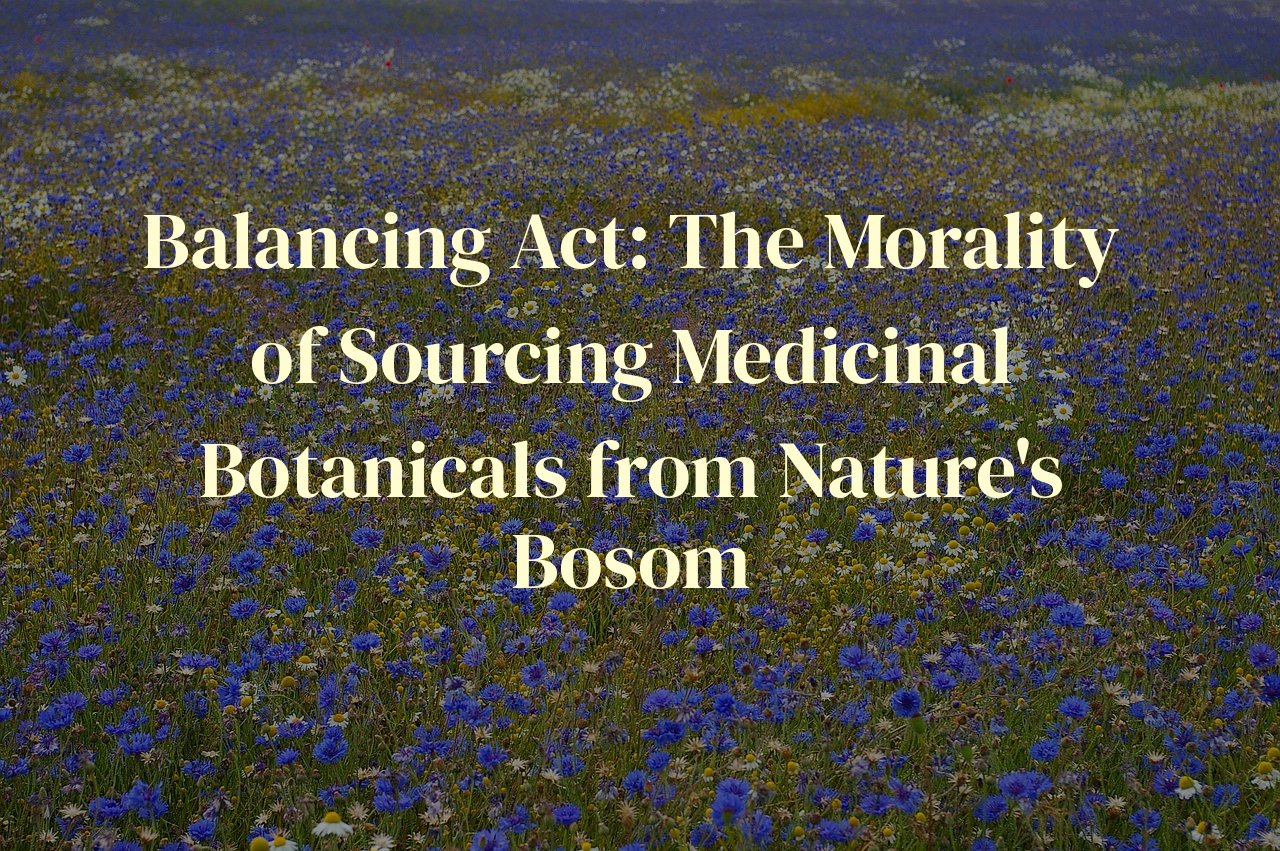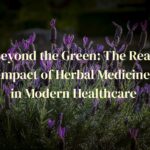
In the quest to blend ancient wisdom with modern health practices, we often turn to the earth’s flora for answers. This blog delves into the intricate dance between the benefits of plant-based medicine and the ethical quandaries posed by sourcing these natural remedies. Specifically, we’ll explore the moral complexities surrounding the extraction of medicinal plants from their wild habitats – an issue juxtaposing the healing of humans against the potential harm to ecosystems. Through this post, readers will glean insights into sustainable harvesting methods and the impact these choices have on both personal health and environmental stewardship.
Table of Contents
Assessing the Impact on Local Ecosystems
In the heart of biodiversity, where every leaf whispers the secrets of balance, I’ve been struck by the quiet turmoil beneath the soil. Through the lens of my work as a blogger, I’ve seen how the harvest of medical plants can wound the tapestry of local ecosystems. When we pluck a plant from nature’s grasp, we are not just taking a resource but altering a complex web of life. As I share this, picture the cloud forests where I once trod; where orchids bloom and moss drapes like nature’s shawl.
For instance, consider the removal of a single medicinal plant species. To a casual observer, this act may seem innocuous. Yet, what is often unseen is the cascade of effects: the roots that held soil to prevent erosion, the leaves that shaded micro-habitats, the nectar that fed pollinators – all gone. I recall watching a patch of land slowly degrade after excessive harvest of such plants – an unraveling that began subtly, only to become alarmingly evident over time.
Furthermore, in many ecosystems, particular plants play a vital role not just in their physical structure but in the intricate relationships that define an ecological community. Such as the case when I observed a medicinal plant being the cornerstone for an entire network; a specific butterfly species relying on it for food, which in turn became prey for birds. The removal of this plant has a domino effect, impacting species interdependence and potentially leading to biodiversity loss.
We must grasp that in plucking these botanicals, we are sometimes snatching away the hidden threads that bind ecosystems. Within my travels and studies, I’ve come to understand that assessing such impacts require a holistic view, measuring not just the plant’s scarcity, but its role within the broader ecological ballet. Only then can we begin crafting a narrative where healing ourselves doesn’t come at the cost of wounding the planet.
Conservation vs. Cure: Where Do We Draw the Line?
In the heart of every forager and phytotherapist, there lies a profound ethical quandary: the fine line between the conservation of medicinal botanicals and the urgent quest for cures. This is a terrain I’ve navigated personally, where each step, each plucked root or leaf from nature’s verdant archive, prompts a silent but profound moral calculus.
During the early days of my forage into the wild for healing herbs, a sense of limitless bounty surrounded me. The world was an open apothecary, freely offering its remedies. Yet, I quickly learned that this generosity was not without limits. With each return to familiar groves and glens, I noted subtle changes—fewer blooms, a scarcity of once-plentiful species. It became clear that healing ourselves had the potential to harm the very organisms we depended upon. Herein lay the dilemma that would shape my future pursuits: to heal, yes, but not at the cost of the ecosystems that supported these natural pharmacopeias.
Where do we draw the line between healing humanity and hurting nature? This line is as delicate as the veins on a leaf and as crucial as the root systems that intertwine beneath our feet. It is not just about the survival of individual plant species but about the integrity and resilience of entire ecosystems. Recognizing this balance, I began to advocate for sustainable harvesting—a methodology that ensures what is taken does not exceed what can be replenished.
But sustainable harvesting is more than a practice; it’s a philosophy, a commitment to the future. It implies a pact with nature: that we shall not be agents of scarcity but stewards of abundance. Moreover, this philosophy has woven its way into my interactions with local communities, who have, for generations, understood the delicate dance of taking and giving back. Their traditional knowledge has been invaluable, teaching me to read the land, to listen to its rhythms, and to harvest in ways that allow the plants and the local ecosystem to thrive.
Ultimately, drawing the line in our quest for cures is a dynamic and ongoing process, requiring community engagement, continuous education, and a willingness to adapt. Each choice reverberates through the intricate web of life that sustains us. In essence, it is not just a line we draw in the soil; it’s a circle—a promise of regeneration and respect, recognizing that in nurturing nature’s diversity, we fortify our own survival.
Sustainable vs. Exploitive Practices in Plant Harvesting
In the verdant embrace of nature’s pharmacy, the line between responsible stewardship and reckless exploitation of medicinal plants often blurs. As someone who has witnessed the consequences of both approaches first-hand, let me take you on a journey through the undergrowth of ethical plant harvesting.
Sustainable harvesting practices manifest as a symbiotic dance with nature. They involve selective picking that ensures the long-term survival of plant populations. I’ve visited communities where only a fraction of plants are harvested at a time, ensuring others mature and seed, thus maintaining the species’ presence. These harbingers of sustainability also rotate their foraging areas, allowing nature time to rebound—a principle I wish more would adhere to.
On the darker side, exploitive harvesting is akin to a plundering horde, leaving nothing but scarred earth and dwindling species in its wake. These practices often involve taking more plants than can be replenished naturally, a short-sighted gain with hefty ecological checks to cash in the future. I recall a forest, once lush with wild ginseng, now stands desolate, a testament to greed’s ruinous touch.
Erecting a bulwark against such exploitation involves community engagement and education. It’s heartening to recall the times I’ve worked alongside locals, crafting plans for sustainable harvest that respect both their livelihoods and the botanical cornucopia they depend on. Through such collaborative efforts, a middle path can be forged where nature’s bounty is respected, even as it’s utilized.
The choices we make in plant harvesting ripple through the ecosystem. I’ve shared the triumph of a village that pivoted to sustainable harvest and watched its surrounding wilderness flourish—proof that with informed actions, we can tip the scales back towards a balance where both nature and humanity thrive.
Our relationship with medicinal botanicals must be curated with care, for in the whispers of the leaves and the silence of the roots lie the teachings of a world more ancient than our own desires.
Harnessing Traditional Knowledge for Ethical Harvesting
In my journey as a health blogger, I’ve been privileged to witness firsthand the profound wisdom ingrained in traditional practices of harvesting medicinal plants. This is a tale not merely of plants and potions, but of the symbiotic bond which communities nurture with nature’s bounty. Local inhabitants, oftentimes indigenous tribes, have, for generations, communed with the wilderness, discerning the subtle cues of the forest and learning the rhythms of growth and regeneration that govern their botanical neighbors.
One transformative encounter was observing how the tribal healers of the Amazon deftly identify and harvest only what is necessary, guided by a philosophy that marries respect with utility. Ethical harvesting here is rooted in intimate knowledge passed down through the ages; it is knowing the precise moment when a plant is ripe for picking without disrupting its life cycle, thereby ensuring the perpetuity of the species.
These guardians of the forest have taught me that every plant picked is followed by a seed sown, a ritual that helps maintain the delicate balance of the ecosystem. In my articles, I advocate for the codification of such traditional wisdom into modern conservation strategies. By incorporating these ancient principles, we can engender a new era of sustainability, where the harvesting of medicinal plants doesn’t merely take but gives back, fostering a regenerative cycle that nurtures both our health and the health of our planet.
Ultimately, the adoption of ethical harvesting protocols that are informed by traditional knowledge becomes a conduit for conservation. It allows us to honor the legacy of our ancestors while safeguarding the natural heritage for our children. Such practices speak volumes about who we are as a species and the respect we choose to show towards the other inhabitants of our shared home. Through my writing, I implore and inspire, hoping to ignite a collective will to preserve such knowledge not as historical footnotes but as a living dialogue between humanity and the Earth.
The Ripple Effect: How Our Choices Affect Global Biodiversity
Delving into the intricate web of global biodiversity, I've often marveled at the delicate balance that sustains life on our planet. As a health and dietary therapy enthusiast, I've grappled with the ethical implications of sourcing medicinal plants from their wild habitats. Each plant harvested is a thread pulled from nature’s tapestry, potentially unraveling relationships within ecosystems that have thrived for millennia.
Consider the case of the Pacific Yew tree, once the sole source of the cancer drug paclitaxel. The demand for this life-saving compound led to mass harvesting, which in turn had cascading effects on the species that depended on the Yew for survival. This situation highlighted the critical need for sustainable practices in plant harvesting to maintain the equilibrium that diverse species, including humans, rely on.
In my journey, I have witnessed how indigenous communities apply respectful, sustainable harvesting methods, maintaining biodiversity while utilizing nature’s gifts. Their approach often employs rotational harvesting and selective pruning, which preserves the plant populations and ensures their availability for future generations. Emulating such practices on a global scale could mitigate the impacts of exploitative harvesting, fostering a harmonious coexistence with our natural environment.
Reflecting on our interconnectedness, it is clear that our choices echo through the complex networks of global biodiversity. The over-harvesting of plants like Arnica montana, harnessed for its anti-inflammatory properties, has not only threatened the species but also the pollinators that depend on it and the predators that rely on those pollinators. Consequently, each species’ decline can have unforeseen ramifications, illustrating the importance of making ethical and informed decisions in our sourcing practices.
Hence, my resolve to advocate for balancing our health needs with environmental stewardship grows stronger with each botanical study. Understanding that taking too much can leave us with far less, I champion an ethos where each action considers the well-being of our entire planetary community. Only then can we ensure that the healing power of plants is available not just for us, but for all life that shares this world.
Conclusion
The harmony between human health and the natural world hinges on the decisions we make about medicinal plant harvesting. In closing, we acknowledge that the path to maintaining ethical standards in medicine is complex, yet attainable with informed and mindful practices. May our actions reflect a deep respect for the interconnectedness of life, ensuring that the benefits of healing plants are preserved for future generations.



